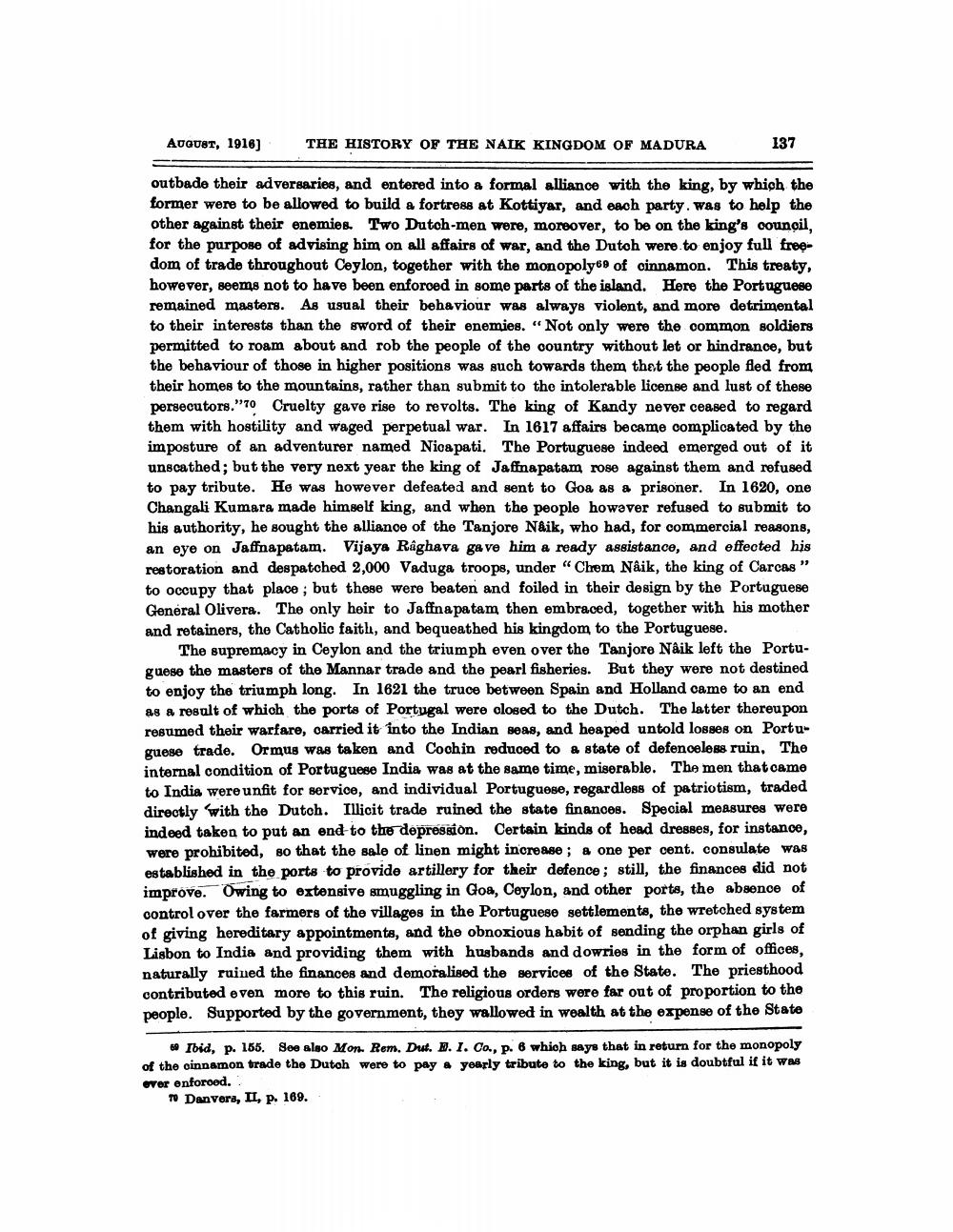________________
AUQUBT, 1916)
THE HISTORY OF THE NAIK KINGDOM OF MADURA
137
outbade their adversaries, and entered into a formal alliance with the king, by which the former were to be allowed to build a fortress at Kottiyar, and each party. was to help the other against their enemies. Two Dutoh-men were, moreover, to be on the king's counçil, for the purpose of advising him on all affairs of war, and the Dutoh were to enjoy full free dom of trade throughout Ceylon, together with the monopolyte of cinnamon. This treaty, however, seems not to have been enforoed in some parts of the island. Here the Portuguese remained masters. As usual their behaviour was always violent, and more detrimental to their interests than the sword of their enemies. “Not only were the common soldiers permitted to roam about and rob the people of the country without let or hindrance, but the behaviour of those in higher positions was such towards them that the people fled from their homes to the mountains, rather than submit to the intolerable license and lust of these persecutors."70 Cruelty gave rise to revolts. The king of Kandy never ceased to regard them with hostility and waged perpetual war. In 1617 affairs became complicated by the im posture of an adventurer named Nioa pati. The Portuguese indeed emerged out of it unscathed; but the very next year the king of Jaffna patam rose against them and refused to pay tribute. He was however defeated and sent to Goa as a prisoner. In 1620, one Changali Kumara made himself king, and when the people howaver refused to submit to his authority, he sought the alliance of the Tanjore N&ik, who had, for commercial reasons, an eye on Jaffnapatam. Vijaya Raghava gave him a ready assistance, and effected his restoration and despatched 2,000 Vaduga troops, under “Chem Náik, the king of Carcas" to occupy that place; but these were beaten and foiled in their design by the Portuguese General Olivera. The only hair to Jaffna patam then embraced, together with his mother and retainers, the Catholic faith, and bequeathed his kingdom to the Portuguese.
The supremacy in Ceylon and the triumph even over the Tanjore Naik left the Portuguese the masters of the Mannar trade and the pearl fisheries. But they were not destined to enjoy the triumph long. In 1621 the truce between Spain and Holland came to an end as a result of which the ports of Portugal were closed to the Dutch. The latter thereupon resumed their warfare, carried it into the Indian seas, and heaped untold losses on Portuguese trade. Ormus was taken and Cochin reduced to a state of defenceless ruin, The internal condition of Portuguese India was at the same time, miserable. The men that came to India were unfit for service, and individual Portuguese, regardless of patriotism, traded directly with the Dutch. Illicit trade ruined the state finances. Special measures were indeed taken to put an end to the depression. Certain kinds of head dresses, for instance, were prohibited, so that the sale of linen might increase ; & one per cent. consulate was established in the ports to provide artillery for their defence; still, the finances did not improve. Owing to extensive smuggling in Goa, Ceylon, and other ports, the absence of control over the farmers of the villages in the Portuguese settlements, the wretched system of giving hereditary appointments, and the obnoxious habit of sending the orphan girls of Lisbon to India and providing them with husbands and dowries in the form of offices, naturally ruined the finances and demoralised the services of the State. The priesthood contributed even more to this ruin. The religious orders were far out of proportion to the people. Supported by the government, they wallowed in wealth at the expense of the State
50 Ibid, p. 166. Soe also Mon. Rem. Dut. 1. 1. Co., p. 6 which says that in return for the monopoly of the oinnamon trade the Dutoh were to pay a yearly tribute to the king, but it is doubtful if it was over enforood.
10 Danvers, II, p. 169.




